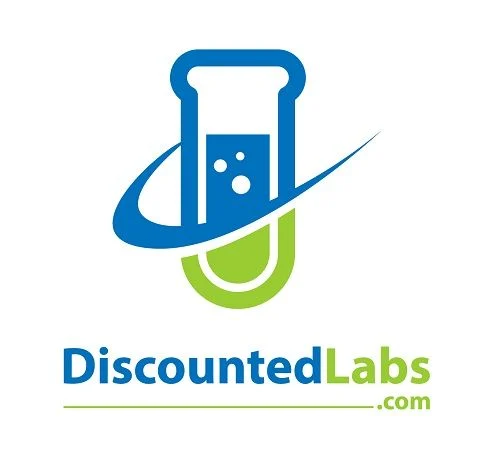Post PCT Panel

First time customer? Read How Discounted Labs Works
IMPORTANT NOTICE ABOUT DISCOUNTED LABS SERVICES: We currently serve the following states:
Alabama, Alaska, Arizona, Arkansas, California, Colorado, Connecticut, Delaware, Florida, Georgia, Idaho, Illinois, Indiana, Iowa, Kansas, Kentucky, Louisiana, Maine, Maryland, Massachusetts, Michigan, Minnesota, Mississippi, Missouri, Montana, Nebraska, Nevada, New Hampshire, New Mexico, North Carolina, North Dakota, Ohio, Oklahoma, Oregon, Pennsylvania, South Carolina, South Dakota, Tennessee, Texas, Utah, Vermont, Virginia, Washington, West Virginia, Wisconsin, and Wyoming.
Other states will be added in the coming months, so please subscribe to our newsletter on the website footer to be notified.
This PCT after cycle panel is designed to measure the health and recovery of the Hypothalamic-Pituitary-Testicular Axis (HPTA) after attempting to normalize it spontaneously or with the use of Post-Cycle Therapy (PCT) . PCT is prescribed by some physicians for men who stop testosterone replacement therapy (TRT) or other androgens. Fasting is required for CMP (glucose test).
PCT Cycle After Steroids: Post Cycle Therapy Panel
This PCT after cycle panel checks the health and recovery of the hypothalamic-pituitary-testicular axis (HPTA) after trying to normalize it naturally or with PCT. For men who stop taking testosterone replacement therapy (TRT) or other androgens, some doctors prescribe PCT. You should fast for 12 hours before collection of the specimen. Fasting is defined as no consumption of food or beverage other than water for at least 12 hours before testing. If using a testosterone cream please be sure you have not rubbed any into the antecubital area of your arm for the last 24 hours as it can give elevated results.
What is a PCT Cycle?
A PCT cycle, or post-cycle therapy cycle, is what bodybuilders and athletes do after a steroid cycle. The goal of a PCT cycle is to stimulate natural hormone production and get the body back to normal after it's been suppressed by steroids. This is done with various medications that help regulate hormone levels and prevent side effects like gynecomastia (enlarged breast tissue in men) and infertility. It's crucial to follow a proper post-cycle therapy protocol to ensure optimal recovery and minimize long-term health risks of steroid use, including preserving muscle mass, strength gains, and kickstarting endogenous testosterone production. Nutrition plays a big role during post-cycle therapy; a diet rich in nutrients can support hormonal balance and overall health. Proper protein intake is necessary to preserve muscle mass, while a balanced intake of carbs and healthy fats will support overall energy and metabolic health.
What is the Post-PCT Panel?
The Post-PCT Panel is a set of tests that checks the health and recovery of your hypothalamic-pituitary-testicular axis (HPTA) after a steroid cycle. Whether you normalized naturally or used PCT, this panel will give you the metrics you need to know your hormonal balance.
Why PCT?
PCT is what you do after a cycle of performance-enhancing drugs like anabolic steroids. While these substances can give you impressive gains, they come with a downside—low testosterone and overall health. Here's the science:
-
The Steroid Effect: Anabolic steroids flood your system with high levels of artificial testosterone. When you stop, your natural testosterone production takes a hit and you'll experience various physical symptoms.
-
The Recovery Phase: Your body will try to reboot its testosterone production naturally. But getting back to hormonal balance can take a long time.
-
PCT's Role: PCT aims to get you back to hormonal balance by stimulating natural testosterone production. But PCT is still not scientifically proven.
Why Do You Need the Post-PCT Panel?
The Post-PCT Panel checks:
-
Testosterone Balance: Supplemental testosterone can suppress your body's natural production and affect Luteinizing Hormone (LH).
-
Sperm Quality: LH suppression also affects Follicle Stimulating Hormone (FSH) which is important for sperm production.
Take this panel at least 4 weeks post-PCT.
What's Included?
The Post-PCT Panel includes:
-
Ultra Sensitive Estradiol (E2) by LC/MS: For men.
-
Total and Free Testosterone LC/MS: No upper limit restrictions. You need to monitor your natural testosterone levels to ensure they bounce back after a cycle.
-
Luteinizing Hormone (LH): For testosterone production.
-
Follicle Stimulating Hormone (FSH): For sperm production.
-
CBC - Complete Blood Count: Includes hematocrit.
-
CMP - Comprehensive Metabolic Panel: Liver and kidney functions, glucose levels, electrolytes.
Why Testosterone Production Matters
Testosterone production is the foundation of overall health and well-being, especially for those who use anabolic steroids. This hormone is responsible for developing primary and secondary sexual characteristics and regulating various bodily functions such as energy levels, muscle mass, sex drive and confidence. When testosterone levels drop, it can greatly affect your health and quality of life, causing decreased physical performance, mood swings, low sex drive and even depression.
For those who use anabolic steroids or prohormones, natural testosterone production is key. Post-cycle therapy (PCT) is the key to getting your body back to hormonal balance after a steroid cycle. By stimulating natural testosterone production, PCT counteracts the negative effects of anabolic steroids and reduces the risk of adverse health outcomes and overall well-being.
Post Cycle Therapies
Post-cycle therapies come in various forms: medications, supplements, and natural methods. Selective Estrogen Receptor Modulators (SERMs) like Clomid and Nolvadex are used in PCT to regulate post-cycle estrogen production and mitigate its side effects. Aromatase Inhibitors (AIs) like Aromasin are used to prevent testosterone from converting to estrogen and create a more balanced hormonal environment.
Human Chorionic Gonadotropin (HCG) is another key medication in PCT that stimulates the testicles to produce natural testosterone. Sometimes HCG is used with SERMs and AIs to make it more effective and to cover all aspects of hormonal recovery.
Besides medications, supplements like phosphatidylserine and acetyl-l-carnitine can help lower cortisol and prevent catabolism. A well-structured diet and exercise routine are also important to maintain muscle mass and get back to hormonal balance, so they are part of an effective PCT plan.
How to Take PCT Medications
Taking PCT medications correctly is key to restoring natural testosterone production and minimizing side effects. Each PCT protocol is different for each individual so consult a doctor before starting any medication or supplement regimen.
A typical PCT protocol would be HCG, SERMs, and AIs. For example:
-
HCG 1000iu every other day for 2 weeks.
-
Nolvadex 40mg daily for 2 weeks and 20mg daily for weeks 3-6.
Follow the instructions and adjust as needed to get the best results and a smooth recovery.
PCT Supplements and Diet
A well-structured diet and exercise routine are key to maintaining muscle mass and getting back to hormonal balance during PCT. A diet rich in protein, healthy fats, and complex carbohydrates will support testosterone production and overall health.
Supplements like testosterone boosters, estrogen blockers, and cortisol reducers can make PCT more effective. But make sure to choose safe and effective supplements and consult a doctor before adding new supplements to your regimen. This way, you're taking the right steps to support your body's recovery and maintain your muscle gains.
Post Cycle Therapy After Anabolic Steroids
The Risks of Anabolic Steroids
Anabolic-androgenic steroids (AAS) or exogenous testosterone has been the go-to option for many health professionals to get bigger muscles and more muscle mass. But this comes at a high price: severe health problems, from heart problems and psychological issues to death. AAS abuse or steroid abuse disrupts the natural testosterone production and leaves individuals with debilitating conditions like extreme fatigue, depression, insomnia, and loss of sexual function. For some, it can lead to suicidal thoughts. Testicular atrophy, which means the testicles shrink, is one of the physical effects of using anabolic androgenic steroids (AAS). This can make it harder to get pregnant and cause hormonal imbalances. The effect of AAS on the hypothalamic-pituitary-testicular (HPT) axis through exogenous administration of testosterone is a concern for users and health professionals. AAS suppresses the endogenous production of testosterone (Pope and Brower, 2005; Reyes-Fuentes and Veldhuis, 1993). Many AAS users resume endogenous production of testosterone after AAS use (Kanayama et al.).
Post Cycle Therapy
Stopping AAS can cause these problems but there is no medical protocol to reverse the health problems of chronic HPT suppression during the transition period. Some men do it on their own and use self-administered post-cycle therapy (PCT) with drugs like hCG, SERM and AI to try to regulate their hormone levels and get their body to produce healthy testosterone again.
The Scottish Clinic Study: PCT Results
A clinical audit from a Scottish addiction service clinic gives us new information on what happens when you stop AAS, how PCT can improve performance and the level of visible body muscularity. The study looked at 613 men who stopped AAS use between 2015 and 2022. Researchers found that a large majority (76%) of these men used PCT, including growth hormone. The results were promising—men who did PCT had a significant increase in their testosterone levels, suggesting a quicker and more likely return to normal hormonal function. PIED consumers who access GPs may also be using polysubstances, but the temporal order of this is still unclear. This study shows how important PCT is in giving AAS users the right information, like how to inject, how effective the substance is, dosage, side effects, and the amount of muscle in the body. Steroids were seen as easier to access than PCT so participants tended to continue using steroids rather than taper down their use and that's a health concern. Interested participants were asked to contact one of the clinics to find out more about the study and how they can be part of it.
PCT Results
The study shows that PCT can increase the chances of the body producing testosterone naturally. Men who used less AAS for a shorter period and who were off AAS for a longer duration were more likely to see their reproductive hormones return to normal when they did PCT. Cortisol management is also important in PCT as it will lower cortisol levels in the body and prevent catabolism, which is the breakdown of body tissues and compounds.
Future Treatment
The importance of PCT as part of PIED use goes beyond physical recovery; it's part of a broader harm reduction strategy for PIED users, especially with mental health considerations. PCT stands for post-cycle therapy. PIED users call the period when they are using PIEDs as "on-cycle" and the period when they are not using PIEDs as "off-cycle" (Hildebrandt, Langenbucher, Lai, Loeb, & Hollander, 2011). PCT is one of the strategies PIED users use to minimize the negative health effects of PIED use both during and after use (see Adair (2015) for non-PCT strategies). This study from Scotland aims to add to the existing literature and make a big leap forward in developing treatment for men who want to stop AAS use. This study adds to the body of research that shows PCT as part of PIED use is a harm reduction measure that allows PIED users to taper off or stop steroids or deal with the negative health effects of their use, especially those related to mental health. More research on PCT use in this population is needed.
Conclusion
Recovering from AAS use can be tough for some users. But with PCT emerging from studies like this one from Scotland, there is hope for those who are suffering from steroid withdrawal. Many AAS users look for substances to use post-cycle to fix the problems that arise when endogenous testosterone production resumes after exogenous AAS use. Stopping AAS use is a crucial step in the recovery process, as many AAS users resume endogenous testosterone production after they stop using steroids (Kanayama et al.). It's a conversation we need to have more, more research and an integrative approach to health and wellness.
If you're PCTing or planning to PCT, consult a doctor. Self-medicating is not safe.
Further Reading
- Self-administration of Post-cycle Therapy Associated with Hormonal Recovery Following Steroid Cessation in Men - Journal of the Endocrine Society, October 2023
- Anabolic Steroids Among Resistance Training Practitioners - PLoS One, 2019
- Recovery of Spermatogenesis Following Testosterone Replacement Therapy or Anabolic-Androgenic Steroid Use - Asian Journal of Andrology, 2016
- Anabolic Steroid Use Disorder - StatPearls, 2022
- CC Improved Testosterone and Sperm Concentration in Hypogonadal Males - Systems Biology in Reproductive Medicine, 2020
- Unjustified Prescribing of CMA and PCT: A Call for Awareness - Journal of Clinical Endocrinology, 2020
Suggested Reading: Testosterone Replacement Blood Test Targets



